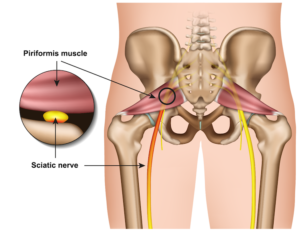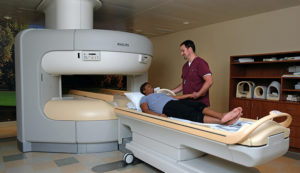What is Piriformis Syndrome?
The Piriformis muscle is located in the buttock area. When a person has Piriformis Syndrome, they experience pain and spasms around this location. Depending on the severity of the condition, it can result in a great deal of pain for the buttocks and the lower back. It can also radiate to the hips, causing areas of numbness.

It isn’t uncommon for someone with Piriformis Syndrome to also struggle with Sciatica. This is because the muscle is nearby the sciatic nerve and the muscle spasms can put pressure on the sciatic nerve. The piriformis muscle begins in the lower region of the spine and connects to the femur on both sides of the body.
This muscle helps with movements when it is healthy and performs correctly. Such movements include turning the leg and foot outward. It is also responsible for rotating the hip when you bend or turn side to side. Piriformis Syndrome can limit such movements or cause a great deal of pain when such movements are attempted. This can make it hard to continue with routine tasks or work responsibilities.
Possible Causes of Piriformis Syndrome
There are several reasons a person may experience Piriformis Syndrome. They include:
- Bleeding close to the piriformis muscle
- Irritation of the piriformis muscle or surrounding areas
- Injury that caused this muscle to become tighter or inflamed
- Swelling around the muscle area and surrounding locations
Piriformis Syndrome Symptoms
The symptoms a person experiences can vary. It depends on underlying factors, the severity of the issue, pre-existing conditions and overall health of a patient. Some patients have several symptoms and others have one or two. The severity of them will also vary from one person to the next since each person has many variables that can effect the symptoms.

Let your doctor know if you experience any of the following:
- Aching around the buttocks
- Numbness
- Pain, especially when on an incline or stairs
- Range of motion around the hip area decreases
- Sitting for a long time makes you uncomfortable and you have to shift or sit on a cushion
- Tingling
Such symptoms can affect the buttocks, the legs, the hips, and even radiate down into the feet. The more details you can share with your medical professional the faster they can get a proper diagnosis. They will schedule some testing so they can confirm the diagnosis as there are other issues that may be similar in symptoms to Piriformis Syndrome.
Piriformis Syndrome Test
It can be hard to test for this problem, and it is usually diagnosed when other issues have been ruled out. The diagnosis process is going to have a lot in common with those who have sciatica. An assessment allows the doctor to get a good idea if you may have Piriformis Syndrome. Make sure you answer all of their questions completely and honestly. Ruling out other causes of the pain often helps this particular diagnosis.
During the physical exam, you may be asked to perform a variety of tasks. This includes bending, twisting side to side, and walking. Let your doctor know if you feel tightness or pain when you do this. The level of pain can help pinpoint the location that it’s radiating from. Your doctor may test your muscle strength and touch muscles to see if you feel any tenderness.
 Your doctor can request some diagnostic testing of the back and spine. This includes CT scans with contrast dye and x-ray. Such imaging doesn’t determine Piriformis Syndrome, but can be used to rule out other problems a patient may experience similar symptoms with. Open MRI scans can also rule out other conditions with similar symptoms as well.
Your doctor can request some diagnostic testing of the back and spine. This includes CT scans with contrast dye and x-ray. Such imaging doesn’t determine Piriformis Syndrome, but can be used to rule out other problems a patient may experience similar symptoms with. Open MRI scans can also rule out other conditions with similar symptoms as well.
Piriformis Syndrome Treatment
Various treatments can help this muscle to heal and feel better. Pay attention to your body. You may need to change your everyday habits and routine to reduce pain and discomfort. Try to rest for several days to give your body time to heal if you recently experienced trauma to the area. The pain should be better when you change positions.
Try to get up and walk around often if you sit for long periods for work. A cushion for your chair or a padded chair can reduce discomfort and pain. If you stand for long periods of time, make sure your shoes give you plenty of support. Try to sit during your breaks to give them a rest. A back brace can help if you engage in repetitive movements where you move your hips from side to side.

Piriformis Syndrome Exercises & Stretching
There are exercises to help reduce problems with Piriformis Syndrome. Your doctor can give you information on how to complete them. The most common types are stretches. Don’t worry if you aren’t as flexible as you would like to be. Your body will loosen up the more you do them. Try to incorporate stretching into your daily routine.
Swimming, yoga, and other forms of low impact exercise can help you feel better. If you have a pinched nerve, the pain may make it harder for you to exercise. Talk to your doctor to determine options for you based on your overall health, your pain level, and where you experience the pain. If you feel numb or tingling sensations, stop exercising as you don’t want to fall or injure yourself.
For severe pain, your doctor may inject steroids to see if this helps reduce it. When the steroids work, it typically confirms the Piriformis muscle is the cause of the pain. It may be necessary to get those injections at regular intervals to feel your best. Losing extra weight can help take off some of the pressure as well.
Piriformis Syndrome Physical Therapy
Your doctor may ask you to go to physical therapy. This can help to strengthen the Piriformis muscle. This treatment is usually a good option when there has been trauma to that muscle and the body is trying to heal. Be patient as it can take several appointments and ruling out other health problems before Piriformis Syndrome is diagnosed and treated.
Different patients respond differently to treatments. It can take time to find exercises that helps rather than makes you feel work. Though if you put forth the effort and work with your doctor to find a solution, you’ll start feeling better soon.


